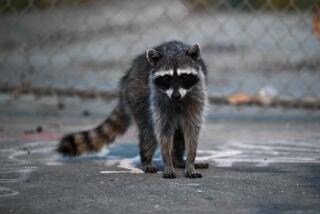Health Unit Tracks Squirrels to Fight Scourge of Plague
- Share via
Armed with syringes, gas masks and toothbrushes, county health officials are testing squirrels in the San Gabriel Mountains for animal plague.
Ground squirrels at two sites already have tested positive for the disease, which appears as bubonic plague when transmitted to people. Officials have closed one campground and are warning all campers to avoid squirrels and fleas, which carry the disease.
The plague can spread to people when “a human gets in the way” of fleas from a dead squirrel looking for a new host, said Robyn Spano, a sanitarian with the county Health Services Department’s vector borne disease unit. “The fleas don’t really like humans that much, but if it’s the first thing they come to, that’s what they’ll feed on.”
On a recent morning, Spano and co-workers Gail Van Gordon and Joe Ramirez took blood samples from three squirrels at the Charlton Flats picnic site in Angeles National Forest. Lured into cages with corn chips, the squirrels were anesthetized with automobile starter fluid, which contains ether.
After blood samples were taken, the squirrels were killed with more ether, then toothbrushes were used to brush their bodies for fleas. Surprisingly, no fleas were found on any of the squirrels.
Temperature a Factor
The number of fleas on a given squirrel varies greatly depending on such factors as temperature and location, but health officials say about 20 fleas may be found on an average squirrel. In an area where animal plague is suspected, state guidelines direct officials to continue emergency flea-control measures until the count drops to an average of 0.3 fleas per squirrel, or lower.
The testing and eradication procedure is a painless and “an extremely humane way to go,” Ramirez said. The squirrels must be killed and their bodies incinerated to avoid the risk of spreading the disease, he said.
In addition to taking blood and flea samples, health officials are also fighting the plague with flea powder, placed around squirrel burrows and in baited cardboard boxes called “dusting stations.”
About 500 squirrels and other small rodents are tested at more than 500 sites in the county each year, according to Barbara Gondo, an environmental health officer with the six-person vector borne unit.
In addition to ground squirrels, plague can also be carried by rabbits, mice, rats and other rodents. Domesticated dogs and cats are less likely to catch the disease, but they can carry the fleas to humans. Health officials are asking campers to keep their pets away from squirrel burrows and dead animals, and to use flea collars and powders.
Gondo said parts of the San Gabriel and Santa Monica mountains are “endemic for plague,” which means that the plague bacteria is always present at a low level. “Hikers should always be aware that there is a possibility that they may be exposed to plague when they visit these areas,” she said.
In tests on July 13 and 14, five out of eight squirrels captured at the Charlton Flats campsite tested positive for plague. Two of seven squirrels captured at Barley Flats, a county probation facility, also tested positive.
Officials may reopen the campsite next week, after testing for plague again on Monday, Gondo said. The Barley Flats facility, which is medically supervised, has not been closed.
Plague is “fairly common in the western part of the United States,” with between 10 and 40 cases occurring per year, according to Allan Barnes, director of the plague branch of the federal Centers for Disease Control in Ft. Collins, Colo.
He said there have been eight confirmed cases of plague in 1988, none of them fatal. There were two fatal cases last year.
Caused by the Yersinia pestis bacteria, animal plague usually occurs in humans as bubonic plague. The disease can be spread to people by the bite of an infected flea and by handling infected animals. If untreated, the disease can spread into the bloodstream as septicemic plague and attack the lungs as pneumonic plague.
Symptoms include enlarged and tender lymph nodes, hemorrhaging under the skin, fever, delirium, headaches, muscle aches, diarrhea and vomiting. The plague can be cured with antibiotics if it is diagnosed in time, ideally within four days after symptoms appear, Barnes said.
Barnes said the modern plague is biologically identical to the “Black Death” which spread through Europe in the mid-14th Century, killing at least 25 million people.
But one crucial aspect of the disease has changed. Once common in urban areas, the plague is now carried by wild animals in rural areas. As a result, Barnes said, “human cases tend to come up as isolated events.”
The last major worldwide epidemic of plague started in the inland areas of China in the 1860s. It migrated to rat populations in Hong Kong and Canton and then spread around the globe, causing “literally millions and millions of cases,” Barnes said.
The plague eventually spread to San Francisco, which reported North America’s first human plague case in 1900. The last major outbreak of plague in the United States was a pneumonic plague epidemic that struck Los Angeles in 1924 and 1925, killing more than 30 people.
Penicillin and other antibiotics were used to fight the disease, and by the 1950s, worldwide cases of the plague could be counted in the thousands instead of the millions, Barnes said.
More to Read
Sign up for Essential California
The most important California stories and recommendations in your inbox every morning.
You may occasionally receive promotional content from the Los Angeles Times.













